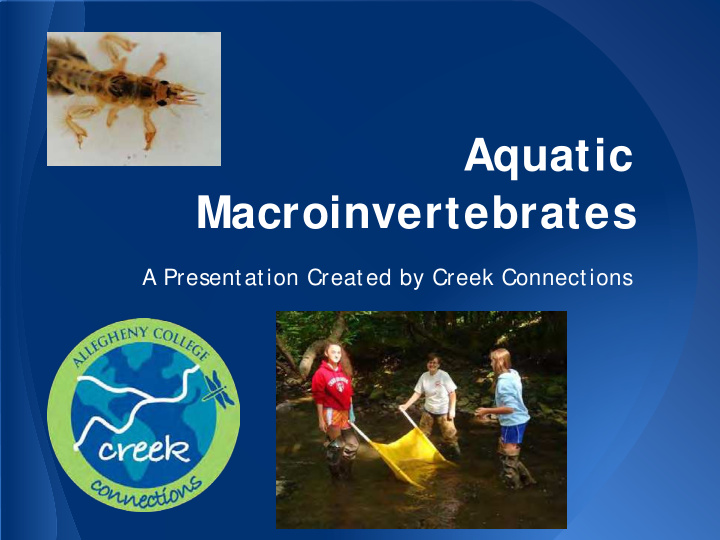



Aquatic Macroinvertebrates A Presentation Created by Creek Connections
Aquatic Macroinvertebrates • 7% of the 91,000+ insects in North America are aquatic or semi-aquatic • They are found in every type of waterway
Aquatic Macroinvertebrates What is a macroinvertebrate? • Lack internal skeletons • Visible by unaided eye Includes: • Arthropods -Insects in all life cycles -Crustaceans -Arachnids • Mollusks http://www.thomasames.com/in • Worms sects/other/ http://www.thomasames.com/insects/other/
Benthic Macroinvertebrates What is Benthic? Bottom-dwelling Mayfly nymph Alderfly larva S ubstrate
Aquatic Insects Life Cycles Many insects start their lives in water Juvenile Adult Dragonfly Metamorphosis
Aquatic Insects Complete Metamorphosis -Egg -Larva -Pupa -Adult http://www.kidfish.bc.ca/caddisfly.htm
Aquatic Insects Incomplete Metamorphosis -Eggs -Nymph -Adult http://www.naturenorth.com/dragonfly/DOM/Page02_Life_Cycle.html Explore More: -http://www.kidfish.bc.ca/insects.htm -Do the “Aquatic Insect Life Cycle” Activity from module
Aquatic Insect Anatomy http://www.dnr.state.md.us/education/envirothon/aquatic_insect_ecology.html
Aquatic Insect Anatomy Head http://www.life.umd.edu/entm/shultzlab/snodgrass/Lecture1/indexq.htm
Aquatic Insect Anatomy Thorax http://ntugre.blogspot.com/2010_07_01_archive.html
Aquatic Insect Anatomy Abdomen http://www.sccs.swarthmore.edu/users/03/cweiss/bugs/glossary.html Explore more: -http:/ / www.dddi.org/ enttutorial/ insect_anatomy/ insectanatomy.html -Do the “Aquatic Insect Parts and Pieces” Activity from module.
Aquatic Insect Anatomy Aeropneustic- "Air breathing" -S norkel Approach Respiratory Horns Mosquito Pupa Water Scorpion http://entnemdept.ufl.edu/fasulo/vector/chapter_03.htm
Aquatic Insect Breathing Aeropneustic- "air breathing" -S cuba Approach -Able to survive in low dissolved oxygen settings -Low oxygen can be a sign of pollution http://www.microcosmos.nl/bugs2/lbbouwabd.htm
Aquatic Insect Breathing Hydroneustic-"Water Breathing" -Breathing through Gills http://whatcom.wsu.edu/4-h/nrs/waterbugs/ex.html http://www.cals.ncsu.edu/course/ent425/tutorial/aquatic.html -Need sufficient DO levels to survive
Where Aquatic Insects Live • FACTORS to consider: • Necessary habitat • Food availability • Appropriate water conditions • S ize of the waterway http://www.waterlandlife.org/e- newsletters/may_12/french_creek.html http://www.epa.gov/greatlakes/aoc/kalamazoo.ht ml
Where Aquatic Insects Live Habitat -Place where organism lives that fulfills its need for food, water, shelter, temperature, reproduction, and space Microhabitat Explore More: -Review "Microhabitat" activities from module Illustration Source: Aquatic Entomology by W. Patrick McCafferty, 1998
Where Aquatic Insects Live Microhabitat- Riffle http://www.learnnc.org/lp/editions/mudcreek/6395 Illustration Source: Aquatic Entomology by W. Patrick McCafferty, 1998 Explore More: Review the "Aquatic Macro S ampling" Activity from module
Where Aquatic Insects Live Microhabitat- Pool http://tahoetowhitney.com/Sonora%20Pass%20to%20Tuolu mne/kennedy-canyon-to-dorothy-lake-pass.html Illustration Source: Aquatic Entomology by W. Patrick McCafferty, 1998 Midge larva http://www.troutnut.com/specimen/455
Where Aquatic Insects Live Microhabitat- Leaf Packs http://www.stroudcenter.org/about/index.shtm Cranefly larva Explore more: http://www.marietta.edu/~biol/biomes/wetlands.htm Review the "Artificial Leaf Packs" activity from the module Illustration Source: Aquatic Entomology by W. Patrick McCafferty, 1998
Where Aquatic Insects Live Microhabitat-Plants Macrophytes Algae Illustration Source: Aquatic Entomology by W. Patrick McCafferty, 1998
Where Aquatic Insects Live Micro habitat - On the surface What is t he above insect called? http://www.biosurvey.ou.edu/o kwild/misc/waterstrider.html http://faunanet.gov.au/wos/fac tfile.cfm?Fact_ID=161 Explore more: • Do the “Life at the Surface” Activity from module. Illustration Source: Aquatic Entomology by W. Patrick McCafferty, 1998
Aquatic Insect Feeding Detritus Decomposers Coarse Particulate Organic Matter (CPOM) Cranefly Larva http://fenwick.pvt.k12.il.us/Creek/webpage/ experimt/inverts/bugnumbr.html Illustration Source: Stream Ecology: Structure and Function of Running Waters by J. David Allan, 1995
Aquatic Insect Feeding Fine Particulate Organic Matter (FPOM) Gathering Collectors Filtering Collectors Brushlegged Mayfly Nymph Blackfly Larva Illustrations Source (both): Aquatic Entomology by W. Patrick McCafferty, 1998
Aquatic Insect Feeding Periphyton - algae on rocks Water Penny http://www.vvm.com/~je vans/sfaquaticinvertebra tes/folderaquaticinsects/ wpenn.html Case-building Caddisfly Larva www.rollanet.org/~str eams/ macroinv/caddiscase.j pg Illustration Source: Stream Ecology: Structure and Function of Running Waters by J. David Allan, 1995.
Aquatic Insect Feeding Dragonfly Larva Giant Water Bug http://bruinbooks.com/giantwaterbug.htm Giant Water Bug Illustrations Source (two above): Aquatic Entomology by W. Patrick McCafferty, 1998
Aquatic Insect Feeding Aquatic Food Web
Aquatic Insect Movement Cling to rocks Mayfly nymph http://www.wwf.org.nz/earthsaver/es_18.c Fishfly Larva fm http://www.pbase.com/tmurray74/im Water Penny age/59792311 http://www.vvm.com/~jevans/sfaquatici nvertebrates/folderaquaticinsects/wpen n.html Stonefly Nymph http://www.fishing-in- wales.com/wildlife/insects/stonefly/
Aquatic Insect Movement Burrow in soft, sandy, silty bottoms found in pools or under rocks. Burrowing Mayfly Nymphs http://aquat1.ifas.ufl.edu/gallery4.html http://sherpaguides.com/georgia/flint_river/wi ldnotes/
Aquatic Insect Movement Move around on top of, below, or between rocks. Dragonfly Larva and Case-Building Caddisfly http://www.thomasames.com/insects/other/ www.rollanet.org/~streams/ macroinv/caddiscase.jpg Illustration Source: Aquatic Entomology by W. Patrick McCafferty, 1998
Aquatic Insect Movement Climb on vegetation - macrophytes & algal mats. Damselfly Larva h t tp:// www.kendall-bioresearch.co.uk/odonata.htm Dragonfly Larva http://www.ento.csiro.au/Ecowatch/Primary/in sects/pages/dragonfly_nymph.htm
Aquatic Insect Movement Swim through the water - from bottom to top. Diving Beetle Illustrations Source: Aquatic Entomology by W. Patrick McCafferty, 1998
Aquatic Insect Movement Float right below water surface. Water scorpion Mosquito larva http://www.backyardnature.net/yucatan/wi http://www.szgdocent.org/ff/f-wtrbg2.htm ggtail.htm
Aquatic Insect Movement Skate on the water surface. Whirligig Beetle http://www.szgdocent.org/ff/f-wtrbg3.htm Water Strider http://www.biosurvey.ou.edu/okwild/misc/waterstrider.ht ml
Aquatic Insect Movement Drift · Escape pollution · Escape lowering of water · Find better food resources · Escape predators · Avoid overcrowding · Find a better spot Explore more: • Do the “Create an Aquatic Macroinvertebrate” Activity from module.
River Continuum Concept Describes and compares the gradual changes in a stream system from headwaters (start) to mid-order creek to mouth. Shows how the insect feeding habits and movement differ as you go downstream from small stream to big creek or river.
Headwaters River Continuum Concept Cranefly Larva Stonefly Nymph http://www.epa.state.oh.us/dsw/wqs/headwater
River Continuum Concept Headwaters Mayfly nymph http://www.wwf.org.nz/earthsaver/es_18.cf
River Continuum Concept Mid-order South Branch of French Creek Illustration Source (all): Stream Ecology: Structure and Function of Running Waters Photos source: Creek Connections by J. David Allan, 1995.
River Continuum Concept Mid-order Illustration Source: Stream Ecology: Structure and Function of Running Waters by J. David Allan, 1995.
River Continuum Concept Mouth http://www.panoramio.com/photo/28680516 Confluence of Kiski and Allegheny River
River Continuum Concept Mouth Water S trider
River Continuum Concept Focuses on: Food Conditions Headwaters Habitat Conditions Mid-Order Explore More: •http://www.cotf.edu/ete/modules/waterq/ wqcontinuum.html Mouth
Insects Reveal Stream Health Woodcock Creek Indian Run http://www.stroudcenter.org/research/projects/Stream watch/sites/east_branch/site18.shtm
Insects Reveal Stream Health Chemical Testing vs. Biological Testing Aquatic Insects are Indicator Organisms They will show if there have been negative changes in water quality or habitat conditions.
Insects Reveal Stream Health Pollution-S ensitive Group I Organisms Illustrations sources: Monitor’s Guide to Aquatic Macroinvertebrates, Save Our Streams – Izaak Walton League of America, 1994 and Aquatic Entomology by W. Patrick McCafferty, 1998
Insects Reveal Stream Health Facultative Group II Organisms Illustrations sources: Monitor’s Guide to Aquatic Macroinvertebrates, Save Our Streams – Izaak Walton League of America, 1994 and Aquatic Entomology by W. Patrick McCafferty, 1998
Recommend
More recommend